Introduction
It’s no secret that technology has revolutionized almost every aspect of our lives. From communication to entertainment and beyond, technology has made many aspects of our day-to-day lives easier and more efficient. The medical field is no exception. Technology has had a huge impact on the way we diagnose, treat, and manage medical conditions. In this article, we will explore some of the ways technology has changed the medical field.

Exploring the Benefits of Telemedicine
Telemedicine is the use of digital information and communication technologies to provide and support health care when distance separates the participants. It is an invaluable tool for providing access to medical care in remote or underserved areas. With telemedicine, doctors can assess and diagnose patients remotely, eliminating the need for physical contact in many cases. This has been particularly beneficial during the COVID-19 pandemic, as it allows doctors to interact with their patients without putting either party at risk of infection.
Telemedicine has also made it easier for patients to access medical care. Patients no longer have to take time off work or make long trips to see a doctor. Instead, they can simply log onto their computer or smartphone and connect with a doctor virtually. This makes it much easier for people to get the medical attention they need.

How Artificial Intelligence is Being Used in Diagnostics
Artificial intelligence (AI) is a branch of computer science that deals with creating intelligent machines capable of performing tasks that would normally require human intervention. AI has the potential to revolutionize the way medical diagnoses are made. By leveraging AI algorithms, doctors can more quickly and accurately diagnose illnesses and diseases. AI can also be used to analyze large amounts of data to generate insights that can help inform treatment decisions.
AI-based diagnostics are already being used in the medical field. For example, AI-powered imaging software can detect signs of cancer in medical images more quickly and accurately than traditional methods. AI can also be used to identify patterns in patient data that may indicate certain diseases.
Examining the Impact of Wearable Technology
Wearable technology is any device or system worn on the body that can collect, monitor, and transmit data related to health or fitness. Examples include smartwatches, fitness trackers, and medical alert systems. Wearable technology has numerous applications in the medical field. For example, fitness trackers can be used to track physical activity, heart rate, and sleep quality. Smartwatches can be used to monitor blood pressure and other vital signs. Medical alert systems can be used to alert family members or medical personnel in the event of an emergency.
Wearable technology can also be used to monitor chronic conditions such as diabetes or heart disease. For example, continuous glucose monitors allow diabetics to track their glucose levels in real time. This can help them better manage their condition and reduce their risk of complications.

Analyzing the Role of Robotics in Surgery
Robotics has become increasingly important in the medical field. Robotic surgery, also known as robot-assisted surgery, is a type of minimally invasive surgery that uses robotic arms to perform complex surgical procedures. Robotic surgery is less invasive than traditional open surgery and can lead to fewer complications and faster recovery times. It also allows for greater accuracy and precision during surgery.
Robotic surgery is being used for a variety of different procedures, including hysterectomies, prostate removals, and cardiac surgeries. It is also being used in orthopedic surgeries such as hip and knee replacements. Robotic surgery has the potential to revolutionize the way surgeries are performed and could lead to improved outcomes for patients.
Investigating the Use of 3D Printing for Prosthetics and Implants
3D printing is a manufacturing process in which a three-dimensional object is created by adding material layer by layer. In the medical field, 3D printing is being used to create customized prosthetics and implants. 3D printed prosthetics and implants can be tailored to the exact measurements of the patient, resulting in a more comfortable fit and improved performance.
3D printing is also being used to create replacement organs and tissues. Scientists are using 3D printing to create structures that mimic the function and structure of natural organs, such as kidneys and hearts. This could potentially revolutionize the organ transplant process and save countless lives.
Conclusion
Technology has revolutionized the medical field in countless ways. From telemedicine to artificial intelligence and robotics, technology has enabled us to diagnose, treat, and manage medical conditions more effectively and efficiently. Wearable technology and 3D printing are also making it easier to customize prosthetics and implants for patients. These advances are transforming the way healthcare is delivered and improving outcomes for patients around the world.
(Note: Is this article not meeting your expectations? Do you have knowledge or insights to share? Unlock new opportunities and expand your reach by joining our authors team. Click Registration to join us and share your expertise with our readers.)
